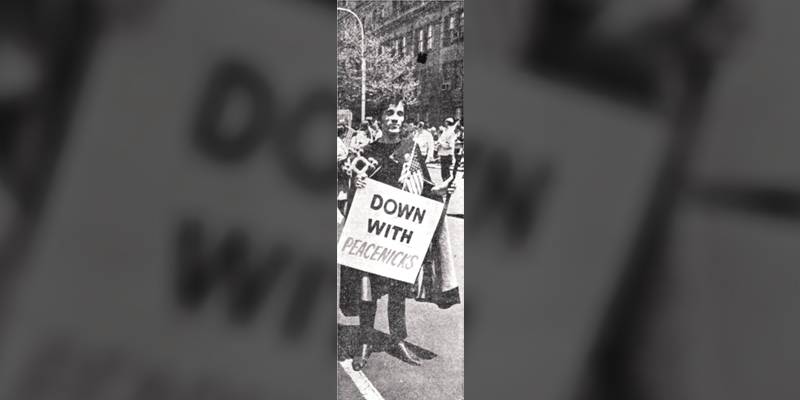
This photograph shows an activist at a demonstration on May 20, 1970 when more than 100,000 New Yorkers marched through lower Manhattan to show their support for the Vietnam War and the Nixon administration.
This was not the first outpouring of Vietnam warmongering from New Yorkers. On May 13, 1967, 43-year-old Fire Department Captain Raymond W. Gimmler led 70,000 pro-war marchers down Fifth Avenue. Gimmler’s branding for the event was simple: either you supported the troops, or you supported the flag-burning communists. Many unions participated, though the views of the rank and file were nuanced. Union members tended to support an end to the war in line with or in greater numbers than the general population, but they just couldn’t stand the anti-war movement.
The 1967 protest presaged the Hard Hat Riot of 1970. By then, American public opinion had turned against the war considerably, especially after the horrific Kent State shootings, in which the National Guard had killed four students during a protest. Mayor John Lindsay ordered flags lowered to half-mast in New York City. Students and other peace protesters gathered on the corner of Wall Street and Broad Street on the morning of May 8, 1970, to hold a vigil.
Before long, they were flanked by 200 angry construction workers. The Building and Construction Trades Council was run at the time by Peter Brennan, a major supporter of President Nixon. With the police doing little to interfere, the construction went to town on the protesters, focusing on long-haired hippie types, and beating them with their “hard-hat” helmets and other equipment. This hooligan outbreak can be viewed as one of many fissures between the left-wing/working class coalition that dominated politics from the New Deal through the Great Society.
Pro-war construction workers and their allies disrupted the Wall Street area every day for the next two weeks, often to cheers from their friends in the financial industry, culminating in a massive demonstration (estimates range from 60,000-150,000) on May 20, 1970. “Flags, fervent oratory, patriotic tunes and river of yellow, red and blue hard hats,” summarized the New York Times, as marchers sported signs denouncing “Hanoi Lindsay.” The demonstration was sponsored by the Building and Construction Trades Council of Greater New York, members of which were invited to the White House for a photo shoot with Nixon about the need to expand the war to Cambodia. Peter Brennan was soon named the Secretary of Labor by Nixon and stayed on through the Ford administration.
This was not the first outpouring of Vietnam warmongering from New Yorkers. On May 13, 1967, 43-year-old Fire Department Captain Raymond W. Gimmler led 70,000 pro-war marchers down Fifth Avenue. Gimmler’s branding for the event was simple: either you supported the troops, or you supported the flag-burning communists. Many unions participated, though the views of the rank and file were nuanced. Union members tended to support an end to the war in line with or in greater numbers than the general population, but they just couldn’t stand the anti-war movement.
The 1967 protest presaged the Hard Hat Riot of 1970. By then, American public opinion had turned against the war considerably, especially after the horrific Kent State shootings, in which the National Guard had killed four students during a protest. Mayor John Lindsay ordered flags lowered to half-mast in New York City. Students and other peace protesters gathered on the corner of Wall Street and Broad Street on the morning of May 8, 1970, to hold a vigil.
Before long, they were flanked by 200 angry construction workers. The Building and Construction Trades Council was run at the time by Peter Brennan, a major supporter of President Nixon. With the police doing little to interfere, the construction went to town on the protesters, focusing on long-haired hippie types, and beating them with their “hard-hat” helmets and other equipment. This hooligan outbreak can be viewed as one of many fissures between the left-wing/working class coalition that dominated politics from the New Deal through the Great Society.
Pro-war construction workers and their allies disrupted the Wall Street area every day for the next two weeks, often to cheers from their friends in the financial industry, culminating in a massive demonstration (estimates range from 60,000-150,000) on May 20, 1970. “Flags, fervent oratory, patriotic tunes and river of yellow, red and blue hard hats,” summarized the New York Times, as marchers sported signs denouncing “Hanoi Lindsay.” The demonstration was sponsored by the Building and Construction Trades Council of Greater New York, members of which were invited to the White House for a photo shoot with Nixon about the need to expand the war to Cambodia. Peter Brennan was soon named the Secretary of Labor by Nixon and stayed on through the Ford administration.

